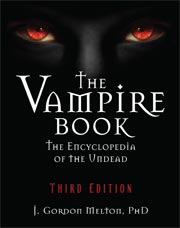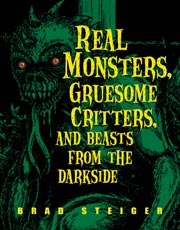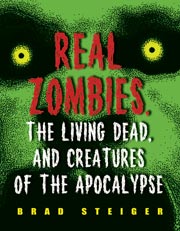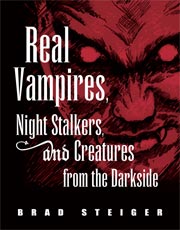The Werewolf of London (movie, 1935)
The first full-length cinematic treatment of the werewolf legend presented a rather sanitized version of the lycanthrope. The Werewolf of London (1935) includes none of the traditional elements of sorcery, Satanism, sadism, cannibalism, or sexual perversion. Although in the folklore of most cultures, the vampire and the werewolf play off one another to the point where they are often indistinguishable, The Werewolf of London establishes the wolf man in the cinematic mold of the Jekyll/Hyde process of transformation. In the new Real Unexplained of the werewolf fashioned by Universal, a person who is bitten or scratched by a werewolf becomes a two-legged man beast, who sprouts thick facial hair, long fangs, and dangerous claws, but retains the basic human shape, complete with clothing. There is no total shape-shifting into a four-legged wolf.
This Hollywood formula for the making of a werewolf was applied to Lon Chaney Jr. in The Wolf Man (1941) and to Oliver Reed, The Curse of the Werewolf (1961) and to most cinematic lycanthropes until The Howling and An American Werewolf in London in 1981 when astonishing special effects allowed audiences to witness complete transformations of the bitten or scratched victims into demonic wolf creatures.
The Werewolf of London casts the superb character actor Henry Hull as Dr. Wilfred Glendon, an English botanist who has traveled to Tibet in search of the Marifasa Lupina, a rare flower that blooms by moonlight only on the Tibetan plateau. While on safari, Glendon manages to find a specimen of the flower, but he is bitten by a strange creature when it rises up to attack him. Ignoring the wound in his triumph of discovery, the botanist returns to his laboratory in London. To his utter despair and confusion, he finds himself changing into a werewolf during the next full moon. As if this were not disheartening enough, the scientist knows that he was the manbeast who attacked and killed a woman in the darkened streets of London. A mysterious Asian gentleman named Yogami (Warner Oland) seeks out Dr. Glendon and informs him that he was bitten by a werewolf in Tibet and, since he survived, he is now destined to undergo the transformation to the wolf man each full moon. The only known antidote, Yogami explains, is the moon poppy, the Marifasa Lupina.
Although Dr. Glendon tries his best to resist the effects of the curse, he runs amok on the following night and kills again. When it appears that London is under siege by two Jack-the-Ripper type monsters, Dr. Glendon knows that there must be two werewolves stalking the darkened streets of the city. Yogami admits that he is also a werewolf, and the two manbeasts fight for the possession of the one antidote that can return them to normalcy. The scientist manages to eliminate Yogami, but before he can ingest the flower, his befuddled werewolf mind has him about to tear out the throat of his own beloved wife (Valerie Hobson). The London police arrive with few moments to spare and shoot the Werewolf of London, who, in his dying gasps, reverts to his human form as Dr. Wilfred Glendon.
Henry Hull (1890-1977) made his stage debut in 1911 and became a leading man in such silent pictures as A Square Deal (1917), Little Women (1918), and The Hoosier Schoolmaster (1924). His highly successful portrayal of "MagWitch" in the film version of Charles Dickens's Great Expectations (1934) no doubt won him the role of Dr. Wilfred Glendon in The Werewolf of London. Excellent character actor that he was, the Kentucky-born Hull did not really fit the role of a supercilious English botanist, decked out in cap and tweeds, who suddenly found himself changing into a werewolf. In addition, he had no desire to emulate such horror masters as Boris Karloff or Lon Chaney Sr. and appear on camera in the kind of grotesque monster makeup effects that had made them famous. Neither did he have any wish to submit to long hours in makeup, sitting patiently while Jack Pierce labored to transform him into a lycanthrope. Faced with his star's recalcitrance, Pierce was presented with the challenge of devising a very light werewolf makeup that could be quickly applied to Hull before his scenes as a werewolf stalking the London streets.
Unable to create the convincing facial transformation into a manbeast that he would later achieve for Lon Chaney Jr. in The Wolf Man, Pierce did the best he could under the circumstances, though some viewers perceived his valiant efforts as having made Hull appear more like a bat-like vampire than a werewolf. Henry Hull enjoyed a long career as an actor and went on to appear in such successful films as The Great Waltz (1938), Jesse James (1939), High Sierra (1941), Lifeboat (1944), The Great Gatsby (1949), and The Buccaneer (1958).
Although he was Swedish, actor Warner Oland (1880-1938) played the title role of the notorious Fu Manchu in The Mysterious Dr. Fu Manchu (1929) and The Return of Dr. Fu Manchu (1930). He assumed the persona of the beloved Chinese detective Charlie Chan in 1931 (The Black Camel, Charlie Chan Carries On) and continued playing the wise Asian crimebuster until his death in 1938. By the time he enacted the role of Yogami in The Werewolf of London, he had already been typecast as an Asian.
From The Werewolf Book: The Encyclopedia of Shape-Shifting Beings, Second Edition by Brad Steiger, (c) 2012 Visible Ink Press(R)
Steiger's homage to the beast within provides meaty facts for the lycanthropic in all of us.
 |
The Werewolf Book: The Encyclopedia of Shape-Shifting Beings, Second Edition
by Brad Steiger
When Darkness Reigns and the Full Moon Glows, Terror Emerges to Stalk the Unsuspecting…
Read More »
|
|
 |
The Vampire Book: The Encyclopedia of the Undead, Third Edition
by J. Gordon Melton, PhD
The Ultimate Collection of Vampire Facts and Fiction
Death and immortality, sexual prowess and surrender, intimacy and...
Read More »
|
|
 |
Real Monsters, Gruesome Critters, and Beasts from the Darkside
by Brad Steiger
Beware! Monsters are Everywhere
Monsters have been spotted everywhere, not just slithering under a child's bed or lurking in...
Read More »
|
|
 |
Unexplained! Strange Sightings, Incredible Occurrences, and Puzzling Physical Phenomena, 2nd Edition
by Jerome Clark
The truth is out there, but looking for it is the real fun. Now, countless X-philes and insatiable fans of the supernatural, occult, and UFOs can...
Read More »
|
|
 |
Real Zombies, the Living Dead, and Creatures of the Apocalypse
by Brad Steiger
The macabre secret history of the undead . . .
Featuring 30 chilling stories of real life zombie encounters, this comprehensive and...
Read More »
|
|
 |
Real Vampires, Night Stalkers, and Creatures from the Darkside
by Brad Steiger
Not only do vampires exist, they walk among us! Paranormal researcher extraordinaire, Brad Steiger, reveals that real vampires are not immortal, do...
Read More »
|
|










